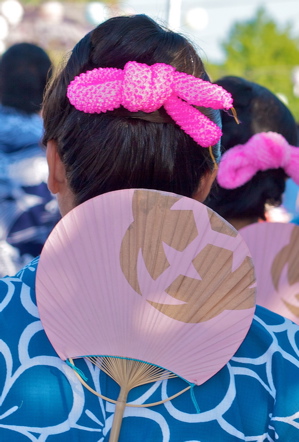JULY and AUGUST: Dancing, intricate costumes and a celebration of Japanese culture begins as the spirit of Obon circles the globe. Worldwide, this festival spans an entire month: “Shichigatsu Bon,” celebrated in Eastern Japan, begins in mid-July; “Hachigatsu Bon” commences in August; “Kyu Bon,” or “Old Bon,” is observed annually on the 15th day of the seventh month of the lunar calendar (in 2018, celebrated in late August of the Gregorian calendar).
2018: International celebrations vary between mid and late July—as they are in the Bay area of California, and Anaheim—and throughout the summer, as are the famous Bon Dance festivals of Hawaii.
Born of Buddhist tradition and the Japanese custom of honoring the spirits of ancestors, Obon is a time for homecomings, visiting family gravesites, dances, storytelling and decorating household altars. Light cotton kimonos, carnival rides and games and festival foods are common at during this season. Obon has been a Japanese tradition for more than 500 years.
Watch it! In “The Karate Kid Part II,” there is an Obon dance scene: watch part of it on YouTube, here.
OBON AND ULLAMBANA: ‘HANGING UPSIDE DOWN’

Participants in an Obon festival, Japantown, San Jose, California. Photo by Mark, courtesy of Flickr
“Obon,” from Sanskrit’s “Ullambana,” suggests great suffering, as the full term translates into “hanging upside down.” Bon-Odori—and the Buddhist legend it stems from—recall a disciple of Buddha who used supernatural abilities to look upon his deceased mother. When the disciple saw that his mother had fallen into the Realm of Hungry Ghosts and was suffering, he asked Buddha how he could help her. The disciple made offerings to Buddhist monks who had just completed their summer retreat and, soon after, saw his mother released from the Realm of Hungry Ghosts.
With his new-found insight, the disciple suddenly saw the true nature of his mother—her selflessness, and the sacrifices she had made for him—and with extra joy, he danced what is now the Bon-Odori. A primary purpose of Obon is to ease the suffering of deceased loved ones while expressing joy for the sacrifices loved ones have made.
BON ODORI DANCING & TORO NAGASHI LANTERNS
The official dance of Obon, though it follows a universal pattern, differs in many details by region. Music and steps typically reflect a region’s history, culture and livelihood. In addition, some regions incorporate items such as fans, small towels or wooden clappers into the dance, while others do not. Nonetheless, everyone is welcome to join in the Bon-Odori dance. When the festival draws to a close, paper lanterns are illuminated and then floated down rivers, symbolizing the ancestors’ return to the world of the dead (Toro Nagashi). Fireworks often follow.
Outside of Japan, the festivities of Obon resonate through Brazil—home to the largest Japanese population outside of Japan—as well as in Argentina, Korea, the United States and Canada.
